Bill Loguidice's Blog, page 119
August 9, 2015
Microsoft Money, Stardock Fences (moving icons), and Evernote with Windows 10
After upgrading to Windows 10 on my Microsoft Surface Pro 3 (from 8.1), my wife’s Surface Pro 3 (from 8.1), my custom iBuyPower desktop (from 7), and my two oldest daughters’ computers, one a Surface Pro 2 and the other an Asus ultrabook (both from 8.1), I ran into only three notable issues, all which I discovered on my desktop.
The first issue was with Microsoft Money. Unfortunately, I haven’t found a suitable replacement for Money and have been using the final Microsoft Money Plus Sunset Edition since its release back in 2009. It still gets the job done and is absolutely critical to how I track and pay all of our bills (and yes, it’s on my to do list to eventually replace the thing). In any case, under Windows 10 it first pops up with an error about needing Internet Explorer 6 to use certain program features. Unfortunately (or, fortunately, actually), Internet Explorer 6 can’t be installed on Windows 10. The solution is a simple registry fix, which is detailed here. Sadly, that wasn’t the final step.
When I tried to download the latest transactions from one of the two banks I use, Money crashed. No matter what I did, every time I started Money, it would crash (and subsequently crush just a bit more of my soul). Fortunately, going here, I was able to fix the final issue with it by replacing a DLL file. The direct link to the DLL and instructions on how to replace it are here.
With that solved, it was now onto eliminating the second issue, and that was with being unable to move icons on the desktop. As a user of Stardock Fences, despite what you might read on various forums, I found the easiest solution simply being to download the latest version of Fences from my Stardock account, install it over the old version, and reboot as instructed. With the updated version of Fences, I was again able to move icons on my desktop, and specifically to the fence I wanted to move it to. All of my previous settings (and icons) were retained without issue.
The third issue was the most minor and that was the screenshot feature of Evernote. Normally a Windows key + Print Scr will allow a capture of all or a portion of what’s on your screen. It seems that that combination is in conflict with what Windows 10 wants to do with it, so I had to change the hot key in Evernote to Ctrl + Windows key + Print Scr. That worked just fine as you can see from the featured image at the top of this very blog post.
Windows 10 has already proven itself a fantastic operating system, but, as with any major change, unexpected issues do crop up. Hopefully they’ll continue to be fully resolvable like these three were.
August 4, 2015
The VideoBrain Family Computer and France’s Old Regime
Among its few claims to fame, the VideoBrain Family Computer Model 101, was the first cartridge-based computer and the first computer with four joystick ports. Its sleek design belies its 1977 origins, albeit with a keyboard of unusual configuration (to be fair, there was a minor movement in that nascent personal computing era to get away from the shackles of typewriter origins that the designers of the VideoBrain likely were at least sympathetic to). While I’ve written quite a bit about this system in the past, and, as a modern day collector, own a fairly complete setup, I continue to be surprised and delighted by information about this system that I’ve either forgotten or never knew of in the first place.
One such bit of info was revealed to me the other day when Paul on the Channel F And VideoBrain Yahoo Group (a mailing list; you should subscribe if you have any interest in either platform) noted an eBay listing for a page from a 1978 Aldens mail order catalog (never heard of them myself), complete with nice scan. Of course this scan was archived and recovered on the list, with Adam Trionfino, who runs Bally Alley (an Astrocade archive), recovering the text. Here’s the ad page:
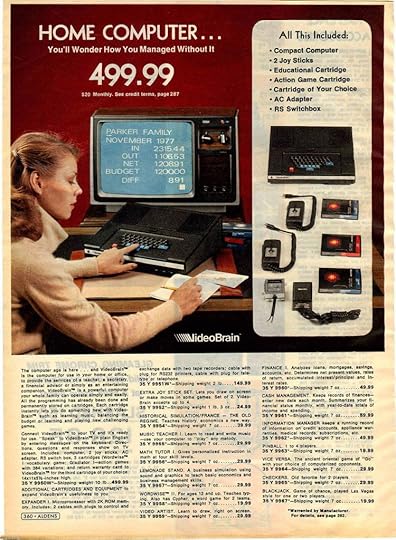
Aldens VideoBrain catalog excerpt (1978).
And here’s the text:
HOME COMPUTER...
You'll Wonder How You Managed Without It
$499.99
$20 Monthly. See credit terms, page287
All This Included:
* Compact Computer
* 2 Joy Sticks
* Educational Cartridge
* Action Game Cartridge
* Cartridge of Your Choice
* AC Adapter
* RS Switchbox
The computer age is here . . . and VideoBrain is the computer for use in your home or office, to provide the services of a teacher, a secretary, a financial advisor or simply as an entertaining companion. VideoBrain is a powerful computer your whole family can operate simply and easily. All the programming has already been done and permanently stored on cartridges. Each cartridge instantly lets you do something new with VideoBrain such as learning music, balancing the budget or learning and playing new challenging games.
Connect VideoBrain to your TV and it's ready for use. "Speak" to VideoBrain in plain English by entering messages on the keyboard. Directions. questions and responses show on TV screen. Includes: computer. 2 joy sticks. AC adapter. RS switch box. 3 cartridges (Wordwise I vocabulary game; Gladiator I - action games with 384 variations; and return warranty card to VideoBrain for the third cartridge of your choice. 14x11x51/2-inches high.
35 Y 9950W*-Shipping weight 10 lb..499.99
ADDITIONAL CARTRIDGES AND EQUIPMENT to expand VideoBrain's usefulness to you.
EXPANDER I. Microprocessor with 2K ROM memory. Includes: 2 cables with plugs to control and exchange data with two tape recorders; cable with plug for RS232 printers, cable with plug for teletype or telephone.
35 Y 9951W* - Shipping weight 2 lb.....149.99
EXTRA JOY STICK SET. Lets you draw on screen or make moves in some games. Set of 2. Video-Brain accepts up to 4.
35 Y 9952* - Shipping weight 1 lb. 3 oz...24.99
HISTORICAL SIMULATION/FRANCE - THE OLD REGIME. Teaches history, economics a new way.
35 Y 9954*-Shipping weight 7 oz........39.99
MUSIC TEACHER I. Learn to read and write music -use your computer to "play" any melody.
35 Y 9955*-Shipping weight 7 oz........29.99
MATH TUTOR I. Gives personalized instruction in math at four skill levels.
35 Y 9956*-Shipping weight 7 oz........29.99
LEMONADE STAND. A business simulation using sound and graphics to teach basic economics and business management skills.
35 Y 9957*-Shipping weight 7 oz........29.99
WORDWISE™ II. For ages 12 and up. Teaches typing. Also has Cypher, a word game for 2 teams.
35 Y 9958*-Shipping weight 7 oz........19.99
VIDEO ARTIST. Learn to draw, right on screen.
35 Y 9959*-Shipping weight 7 oz........29.99
FINANCE I. Analyzes loans, mortgages, savings, accounts, etc. Determines net present values, rates of return, accumulated interest/principal and Interest rates.
35 Y 9960*-Shipping weight 7 oz.........49.99
CASH MANAGEMENT. Keeps records of finances-enter new data each month. Summarizes your financial status monthly, with year-to-date totals of income and spending.
35 Y 9961 *-Shipping weight 7 oz........59.99
INFORMATION MANAGER keeps a running record of information on credit accounts, appliance warranties. medical records, subscriptions, etc.
35 Y 9962*-Shipping weight 7 oz........49.99
PINBALL. 1 to 4 players.
35 Y 9963*-Shipping weight 7 oz........19.99
VICE VERSA, The ancient oriental game of "Go" with your choice of computerized opponents.
35 Y 9964-Shipping weight 7 oz........29.99
CHECKERS. Old favorite for 2 players.
35 Y 9965*-Shipping weight 7 oz........29.99
BLACKJACK. Game of chance, played Las Vegas style for one or two players.
35 Y 9967*-Shipping weight 7 oz........19.99
*Warranted by Manufacturer.
For details, see page 282.
Paul described the find as follows:
"It's from a 1978 catalog from Aldens, an old mail order company, and it's probably most interesting for having descriptions of carts which were never released, so far as we know. Of course you could actually place an order for these carts, so I suppose it's possible a few got into the wild, though if I had to guess, I'd say anyone who ordered them just ended up getting their money back.
I suspect that "Finance I" and "Cash Management" ended up being released as "Financier" and "Money Minder", respectively. There's also a description for "Information Manager", which has turned up as a prototype--"keeps a running record of information on credit accounts, appliance warranties, medical records, subscriptions, etc." So, that gives a good idea of what this program is intended for. These productivity programs were expensive--$50-$60. Some of the game carts go as low as $20.
There's also a brief description for "Historical Simulation/France - The Old Regime" -- "Teaches history, economics [in] a new way." I've always thought this cart sounded interesting. Being listed in the catalog makes me think it was at least near completion, if not finished."
“HISTORICAL SIMULATION/FRANCE – THE OLD REGIME” also caught my eye. Knowing the VideoBrain fairly well like I do, I never recalled seeing such a title. Based on the catalog page description, I thought it might have been an early attempt at a reference work on cartridge, a predecessor to the 1982 release of Visible Solar System for the Commodore VIC-20 and 64, the earliest such reference on cartridge I could think of.
Adam countered with the following:
"The title ... reminds me of the old BASIC (text-only games) like "King," "Kingdom" or "Empire" from the 1970s. Here's a version of the game from "BASIC Computer Games," published by Creative Computing:
http://www.atariarchives.org/basicgames/showpage.php?page=96”
My response was this:
"Hmm, I should have searched before I typed. It seems that "Historical Simulation/France - The Old Regime" (and several variations of the title--I've seen no consensus) has been flagged as one of the rumored, but not confirmed titles. You would think having it in a catalog would mean that it was available to purchase, but that most likely is not the case (and we know was not always the case given catalog lead times), as I'm pretty certain it was never actually released.
Interestingly, said search shows up Adam's own Bally Alley PDF excerpt of Steve Ditlea's excellent historical reference (it too does not contain 100% accurate info, but has proven a valuable resource for obscure systems for me nevertheless), A Simple Guide to Home Computers, where on page 115 there's this mention: "...and Old Regime (a Stanford History professor’s simulation of pre-revolutionary France)." So yet another alternative spelling. Of course in the very next sentence there's a mention of STRUCTURE BASIC, which we know does not exist, only the lightly released APL/S, which, as we all know, the few individuals who own a copy do not wish to participate in having it dumped.
So, I think you're right, Adam, it was probably meant to be in the BASIC kingdom/economic simulation category rather than an actual reference material, lik I incorrectly assumed the name implied."
Paul pointed out the rest of the unreleased titles, again, most likely lost for good, assuming any actual work was ever done on them:
VB-1100 Budget System
VB-1200 Information Manager
ED07 Music Teacher 2 or Musicianship I
ED08 Number Cross
ED09 Historical Simulation — France in the Old Regime
EN07 Challenge Racer
EN08 Music Programmer
EN09 Programmable Football
EN10 Computer Life
In any case, when info like this gets uncovered and discussions like this take place, I think it’s easy to see why I and others like me have such a passion for the history of computers, videogames, and technology.
August 3, 2015
Review: KOVOT Battery Organizer and Tester
 If you’re into electronics, or have kids, or any other number of common scenarios, you need batteries, lots and lot of batteries. The problem with needing batteries all of the time is keeping them handy–let’s face it, that old, disheveled junk drawer just doesn’t cut it. That’s where something like the KOVOT Battery Organizer and Tester comes in so handy.
If you’re into electronics, or have kids, or any other number of common scenarios, you need batteries, lots and lot of batteries. The problem with needing batteries all of the time is keeping them handy–let’s face it, that old, disheveled junk drawer just doesn’t cut it. That’s where something like the KOVOT Battery Organizer and Tester comes in so handy.

The box for the KOVOT Battery Organizer and Tester.
This particular battery organizer holds up to 72 batteries across all popular sizes: AAA, AA, C, D, 9 Volt, and yes, even button cells. The tiny pop-out tester portion features three self-contained ports: port A tests 3V button cells; port B tests AA, AAA, C, and D batteries; and port C tests the friend of smoke detectors everywhere, 9 Volt batteries. When testing, a status of Good is when all three lights, red, yellow, and green are lit; Weak is only red and yellow lit; and Exhausted is when no lights are lit.
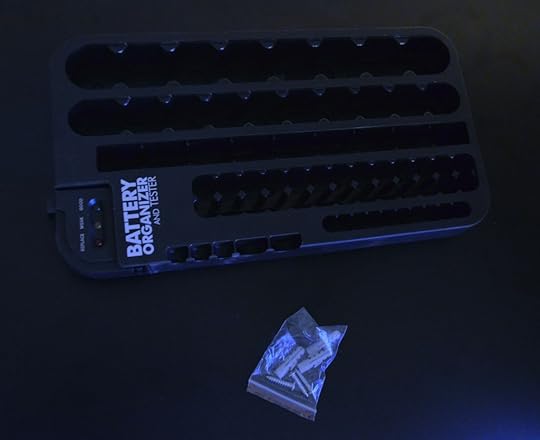
Inside the box is the battery holder with removable tester, as well as wall mounting hardware.
Unfortunately, my battery tester only seemed to work with 9 Volt batteries, so I’m assuming that there’s a loose wire for the A and B ports. Although it appears this may be a somewhat common problem with the tester, fortunately, since it’s sold on Amazon, getting an exchange was easy (it’s on its way).

The removable battery tester is compact and versatile.
For being so accommodating and feature-rich, the KOVOT Battery Organizer and Tester is surprisingly compact, fitting nicely inside most drawers. Of course, you can also mount it on the wall, like I prefer. At only $12.99 on Amazon at the moment, even with the possibility of a flaky battery tester, it’s worth taking a chance on, particularly with Amazon’s liberal (and easy) exchange (or return) policy.

This 9 Volt battery is ready for its smoke detector.
Limited time discount on Gameplay: The Story of the Videogame Revolution!
Good news for fans of our acclaimed feature film documentary, Gameplay: The Story of the Videogame Revolution. For a limited time, it’s available to own through VUDU for only $5.99 (HD or SD)! Check it out, rate it, and be sure to share this info with your friends. We thank you for the continued support!
July 30, 2015
First Impressions of Windows 10 on a Surface Pro 3
Me being me, I couldn’t wait for my turn in the queue, so late yesterday I went directly to the Microsoft download site and downloaded the 64-bit USB/ISO version. When you run the .exe, it gives you the option to install to media or simply start the installer as-is. I chose the latter, figuring I can always create install media if I really needed it in the future.
There was one piece of software I made sure to uninstall first, and that was Stardock’s Start8, which was my Start menu replacement of choice for Windows 8/8.1. It’s my understanding it’s not compatible with Windows 10 (they have a Windows 10-specific version available), which is not a big deal, since I wanted to give the new Windows 10 Start menu a spin (and based on my early usage, I’ll be sticking with the default one).
As expected, the installation went smoothly, although there was one error when it was first downloading the bits for the initial install. This is not surprising as no doubt the Microsoft servers were getting hammered yesterday. In any case, I was able to proceed normally with the installation.
While I didn’t time it, I’d say the whole process from download to install took about one hour over wi-fi. After answering the usual configuration questions (like what to have it automatically do and what-not, which could of course be changed later via Settings), the install was finished and I was in.
Windows is still Windows, but there are settings in very different places and more things to configure than in 8.1, so there is something of a learning/configuration curve. I tried to hit all of the new nooks and crannies where settings are, but I suspect I’ll be discovering and tweaking things continuously over the coming weeks.
Once I was satisfied that the install was stable, I wanted to clean up my disk since I had very little space left. That’s because Windows 10 puts the old version (Windows 8.1) in its own folder on your system for a minimum of 30 days in case you want to go back to it. I have no plans to do that (for better or worse, I’m in for good), so I ran the Disk Cleanup utility and used the option to remove the unneeded system files. That freed up a considerable amount of space on my modest 256GB SSD.
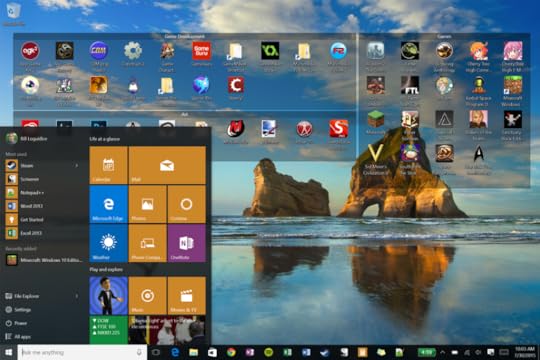
Windows 10 on my Surface Pro 3 showing the Start menu (with activated Cortana integration). Note that the desktop “folders” are actually Stardock’s Fences, which works great on all versions of Windows from 7 onward, including 10.
I haven’t noticed any differences in functionality in terms of OneNote or pen integration, but I do have an issue with OneNote that actually cropped up early on with Windows 8 as well. For the Windows 8/8.1 systems, there was a fix to set the desktop version of OneNote (the one that comes with an Office 365 subscription that I have) as the default for all note functionality, including when you press the button on the Surface’s pen (to quick launch any time). Now, no matter what I do, the Modern version of OneNote launches with the pen button and also when accessing the Note option from the quick launch menu. Naturally, the desktop OneNote still launches and works fine, but as of now, despite setting it as the default version and setting it in the Surface Hub app, it still doesn’t do the quick access stuff. I suspect this will be patched at some point like it was on Windows 8.
Thus far, besides the minor OneNote annoyance (luckily I don’t use it much), the only other annoyance is that, after activating her/its functionality, I can’t set Cortana to wake up by just saying “Hey, Cortana.” I have to click the button first. It also needs some boost in intelligence. Asking it, “What’s the weather like today?” works great, but then asking, “What’s the extended forecast?” gives me the weather for today again. That’s something even Alexa (Amazon Echo) does without issue, so it’s something I suspect Microsoft will address early on in an update as it continues to add to Cortana‘s intelligence/usefulness.
As far as the tablet mode functionality, there are several settings to tweak in that regard. My preference would be for it stay in desktop mode as long as I have the keyboard cover attached, and then to automatically switch into tablet mode when it’s removed. No matter how I tweaked the settings, it didn’t seem to be an option, but I suspect that too will change. In any case, I primarily use the Kindle app in tablet mode and it’s easy enough to tap the “tablet mode” icon in the upper right of the app to make it full screen like it used to be on Windows 8.1. For now, that’s workable. Like the Kindle app, all other Modern Interface apps run like Desktop apps now, so there’s no jarring screen mode switching (unless you specifically want it, like in my Kindle example) and, as a result, it’s a much more seamless experience.
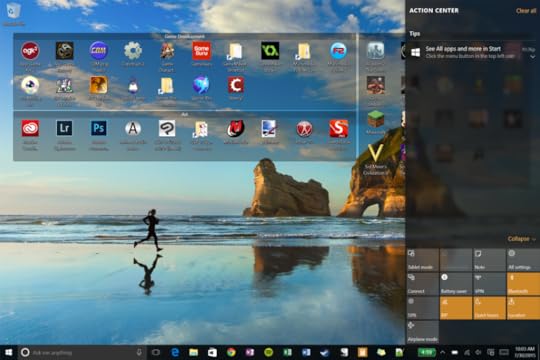
The quick access Action Center, which pulls in from the right.
Since I’m already an owner of the original Windows version of Minecraft, I went through the process of getting the Windows 10 beta version of the game since it’s free for previous owners. After a few failed downloads on the store (again, it’s getting hammered), it installed and I was running it without issue. I’m not much of a Minecraft fan, so I hope I can get it running and similarly activated on my daughters’ computers once I get them upgraded. My wife, who also has a Surface Pro 3, and my two oldest daughters, one who has a Surface Pro 2 and the other who has an Asus touchscreen ultrabook, will likely get upgraded over the weekend as time permits. Considering the various settings that need to be tweaked and the minor change in usability, it’s best for me to be the one who kicks the tires for a few days before bringing them into the fold. I think my Windows 7 desktop will stay with Windows 7 for now, although I reserve the right to change my mind at any time.
So far, I’m fairly satisfied with Windows 10, although it will take some time to get used to the changes and for me to be 100% sure I have it configured exactly how I want. I also suspect some of the failed settings and other minor feature issues will sort themselves out once server traffic returns to normal, or barring that, be addressed in short order in future updates. Right now, it’s at least as stable as the already incredibly stable Windows 7, 8, and 8.1, which is crucial, and the upgrade process itself was fairly painless. I also had no issue running various apps for testing purposes, including some old Steam games, so compatibility appears to be just about perfect, i.e., if it worked in Windows 8.1, there’s no reason for it not to work in Windows 10 (outside of obvious examples with ultra-specific OS functionality, like the aforementioned Start8).
On a final note, I appreciated that the new Edge browser allowed me to import my Favorites from Chrome, which is my primary browser. Although I’ll continue to primarily use Chrome, like Internet Explorer before it, I suspect Edge will be kinder to battery life and will be put to good use when I want to maximize said battery life.
July 29, 2015
What the Definition of Classic and Vintage Videogames and Computers Really Is
The topic of what “classic” or “vintage” means when it comes to videogames and computers is once again rearing its controversial head on various forums and discussion groups. While I have a clear sense of what “classic” and “vintage” mean to me personally in terms of videogames and computers, I readily acknowledge that my interpretation is very much a by-product of having grown up in the late 1970s and 1980s. That’s the problem, really, that what defines “classic” and “vintage” really comes down to when you were born and what platforms make up your youthful memories.
My co-author and I dealt a bit with this topic in the hardware-based sequel to the book, Vintage Games, Vintage Game Consoles, where the greatest game playing platforms of all-time were discussed. Platforms like the Sony PlayStation 3 and Microsoft Xbox 360, although surely qualifying as two of the greatest game playing platforms of all-time, were purposely excluded because their respective stories are still unfolding, i.e., they’re still active on the market. Objectively, that’s what the definition of “classic” and “vintage” in this regard needs to come down to, whether a particular platform is still active on the market. That’s why the newest system covered in Vintage Game Consoles was the Nintendo GameCube, the last significant platform released that is no longer commercially supported (Nintendo’s Wii is just about – but not quite – ready to join its predecessor).
While even I would say that the Sony PlayStation 2, Microsoft Xbox, and Nintendo GameCube don’t feel “classic” or “vintage,” inevitably, given enough time, they will. How much more time needs to pass is again open to individual interpretation. The same applies to the generation after those systems, the generation after that, and then whatever comes after that, ad infinitum, until perhaps the concept behind a “platform” itself is no longer recognizable.
Of course, confusing the debate are platforms like the modern PC (highlighted by today’s official release of Windows 10), which can genuinely trace its roots back to 1981, despite having clear technological dividing lines along the way (DOS, Windows, 2D, 3D, 64-bit Windows, etc.). This was dealt with pragmatically in Vintage Game Consoles by having one chapter devoted to the DOS era of 1981 – 1995, then a separate chapter devoted to the Windows era of 1995 – Present. While one era in that example is definitely older, can’t the era that started 20 years ago also not be argued as “classic” and “vintage?” It made it into the book, so obviously I believe that it can.
So, what’s the solution? The only sane way of delineating platforms is to group them into eras and to put aside overly generic terms like “classic” and “vintage.” Frankly, it’s easier to say things like “Pre-Crash era,” “16-bit era,” etc., as dividing lines than something fairly generic like “classic” or “vintage,” much like I did for the umpteenth time in this 2006 feature on a previous version of our Website. Of course, even those designations are open to interpretation and debate, and we’ll really only have a reasonable solution to the issue if we can have generally agreed upon designations. Perhaps we need a reasonably official meeting of the minds equivalent to the infamous 2006 gathering of the International Astronomical Union (IAU) in Prague that determined Pluto was no longer a major planet. That example made everyone happy and agreeable to new common classifications, right?
July 23, 2015
Super Street Fighter II: The Sexiest Videogames of All Time (07)
In Armchair Arcade‘s ongoing series (first started back in 2012 on the old version of our Website, here and continued on our current site, here), we ask the provocative question, “What makes a particular videogame sexy?” Each feature explores some of the many intriguing approaches game designers have taken over the years to make their games more sensual, not just with increasingly detailed graphics, but also with romantic and seductive gameplay. While some of the games we’ll be looking at are unabashedly low brow, displaying their raw sexuality like a badge of honor, other games in contrast are remarkably subtle, often downplaying their suggestive themes.
Today’s series entry, which is the seventh, features a popular entry in the legendary Street Fighter game series, Super Street Fighter II: The New Challengers, which, specific to our purposes, brought the visuals to a greater level of fidelity:
Super Street Fighter II: The New Challengers
Developer: Capcom
Publisher: Capcom
Initial Release Date: 1993
Platforms: Arcade and most contemporary home platforms
Game Type: Fighting

A portion of the arcade flyer for Super Street Fighter II, showing the rich character designs the game developers had to work from.
When Capcom’s Street Fighter II: The World Warrior was released in 1991, it is no exaggeration to say that it helped invigorate, if only relatively briefly, a moribund arcade industry with its hyperreal, but still skill-based, head-to-head martial arts fighting action. The now legendary game improved upon its prototypical, but wholly unremarkable 1987 predecessor, Street Fighter, in nearly every way, from its audio-visuals to its myriad moves.
Perhaps the biggest single improvement between releases, however, was expanding the number of playable characters from one, a Japanese martial artist named Ryu, to eight (plus four computer-controlled bosses), which included Chinese policewoman, Chun-Li, whose gender was little seen to that point as a lead in any videogame, let alone one that involved hand-to-hand combat. Also unlike the first game, where Ryu’s rival Ken was playable in two player matches, but who played identically, these were fully formed characters, with distinct back stories, looks, personalities, and moves. While Street Fighter II: The World Warrior set the competitive requirement for all future fighting games to have compelling characters, it wasn’t until its first true sequel in 1993, Super Street Fighter II: The New Challengers, that Capcom was able to free themselves from the shackles of incremental Street Fighter II sequels and raise that bar even higher. Not only did Super Street Fighter II feature new hardware that far surpassed the technology that its predecessors ran on, it also introduced four new characters, one of which was another critical female addition, Cammy, a 19-year-old special forces agent from England.

A clip from the opening cut scene providing a hint of what players might expect inside.
Capcom’s designers were free to put the new hardware’s improved audio-visual prowess to good use with a diverse mix of archetypes and original creations among the game’s generous roster of 16 playable characters.
There’s:
Series mainstay, Ryu, whose shout of “Shoryuken” when he performs the jumping uppercut has become as iconic as his karate gi, which is as carefully ripped as his physique.
E. Honda, the burly Japanese sumo wrestler, whose signature move is the “Hyaku Retsu Harite,” which is commonly referred to as the “Hundred Hand Slap.” (Needless to say, that’s a lot of hands to work with.)
Blanka, for those with a shocking fetish for green, Brazilian monsters.
American soldier, Guile, for those who can’t resist a man in uniform.
African American boxer, Balrog, who has the physical presence of a prime Mike Tyson, without all the ugly baggage.
The other series mainstay, Ken, whose exotic mixed American and Japanese heritage and blond hair come in handy against Ryu in the battle of “gaming hunks.”
Russian wrestler, Zangief, who’s so manly that he doesn’t seem to care that his name isn’t even possible within his native language.
Dhalsim, the lanky Indian Yogi who can stretch and lengthen various bodyparts at will, which goes without saying would be a handy skill both in and out of the ring.
Sagat, a Muay Thai style bad boy from Thailand who stands over seven feet tall and possesses massive hands.
Vega, a vain, Spanish Ninjutsu master with the moves of a matador and moviestar good looks that he protects with a mask during his fights.
T. Hawk, an unusual Native American and Mexican amalgam that really gives the player something to think about.
Hong Kong action star, Fei Long, who clearly made the right choice in channeling Bruce Lee’s essence.
Dee Jay, the Jamaican kickboxer, who’s a curious mix of the island’s native flair and American Tae Bo pitchman, Billy Blanks.
M. Bison, would-be dictator, master of the psycho power-infused style, and all around domineering presence.
And then of course, there are the two ladies of Super Street Fighter II.

Some of Chun-Li’s moves are quite “special.”
First up, of course, is trailblazer, Chun-Li, whose thick, muscular thighs have kicked off a thousand fansites. Unlike most of the other female videogame characters on our list, Chun-Li is not rendered as a stereotypical vision of idealized feminine beauty, where it seems a chipped nail might be a major catastrophe. Instead, it’s clear that Chun-Li has trained as hard as anyone for the fights at hand, representing a positive female role model when the norm is still, at best, a bimbo with boobs, or at worst, a damsel in distress. Mario can stay home, because this is one videogame princess who can clearly find her own way out of the castle and look damn good doing it.
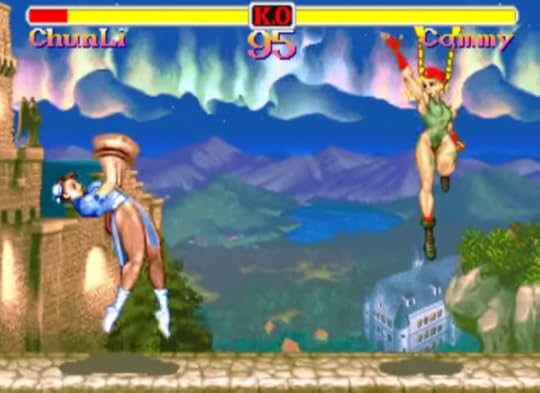
At times, the character models could be beautifully animated.
In contrast to Chun-Li, then series newcomer Cammy was downright twiggy, but certainly no shrinking flower, packing her own sexy, muscular punch. During her signature victory pose where she lithely twists around and shows off her best ass-ets, even die hard fans of Chun-Li realized that there just might be room for one more digital vixen with verve in their hearts.

At other times the character models could be put into some unusual positions.
To say that Super Street Fighter II was a great game because of its sexy characters would be disingenuous. Like any classic, it got the fundamentals right, which in this case was being a finely tuned head-to-head fighting game. For something to be considered a legend, however, it must enhance these fundamentals in some way, and for that, the memorable, sexy characters are part of the total package and a combination that fighting games – which include this game’s descendants – still try to mimic with varying degrees of success today.

The Super Street Fighter II family portrait.
July 22, 2015
Review: Rebelite Xtreme Six Outlet Surge Protector with USB
 Sometimes the simplest of requirements, like finding an extra outlet or two to plug your devices into, can present some of the greatest challenges. Fortunately, they can often have simple solutions, like, in this case, buying additional multi-strip outlets. Nothing fancy or over-engineered is really needed for these situations, just something built well with a reasonable feature-set, preferably for very little money. The Rebelite Xtreme Six Outlet Surge Protector with USB meets that requirement, and then some.
Sometimes the simplest of requirements, like finding an extra outlet or two to plug your devices into, can present some of the greatest challenges. Fortunately, they can often have simple solutions, like, in this case, buying additional multi-strip outlets. Nothing fancy or over-engineered is really needed for these situations, just something built well with a reasonable feature-set, preferably for very little money. The Rebelite Xtreme Six Outlet Surge Protector with USB meets that requirement, and then some.
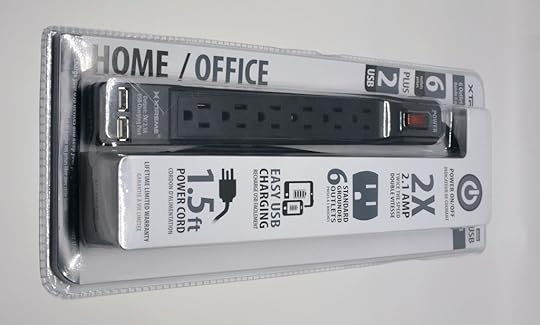
The packaging for the Rebelite Xtreme Six Outlet Surge Protector with USB.
Available for a starting price of only $13.50 on Amazon right now, the Rebelite Xtreme features six standard grounded outlets, as well as two USB charging ports. The USB charging ports deliver 5V/2.1 AMP, so they’re suitable for fast charging even larger USB-based devices, like tablets. The LED indicator illuminates to confirm when grounded surge protection is present. Although I reviewed the black model, white, neon blue, and neon red are also available, with perhaps those latter two colors being the only “Xtreme” thing (other than the missing “E”) about this device.

The multi-strip outlet itself.
While the Rebelite Xtreme has no stated joule rating and therefore is not really meant to protect from surges, that’s not something you’d necessarily need in a multi-strip outlet of this type, particularly at its modest price point. While the 1.5 foot (.46 meter) power cord may be a bit short for some, like the compact body design, this is meant as much for portability as it is for use in a fixed location. While it works great in a home or office setting, this portability also means it’s a great tool for a road warrior’s bag for use in places like a hotel room, coffee shop, or airport terminal.
The Rebelite Xtreme comes with a one year limited warranty.
July 21, 2015
Review: WAVEstream Wireless Bluetooth Speaker
 The WAVEstream Wireless Bluetooth Speaker is just one of many in a crowded field. Fortunately, it has a few features that help it stand out, including a good bass response and a surprisingly low price (presently just $23.99 on Amazon).
The WAVEstream Wireless Bluetooth Speaker is just one of many in a crowded field. Fortunately, it has a few features that help it stand out, including a good bass response and a surprisingly low price (presently just $23.99 on Amazon).
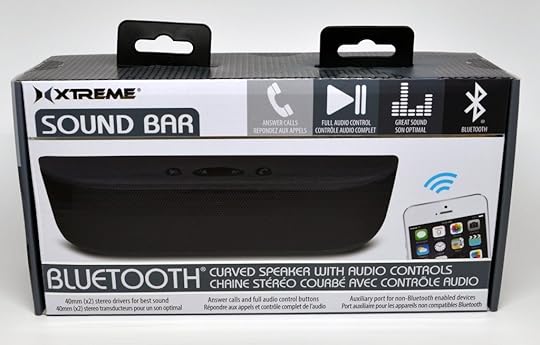
The front of the box for the speaker.
Measuring 8.5 inches (~21.6cm) long by 2 inches (~5.1cm) high, the WAVEsteam is about average for mid-sized units. Available colors are Midnight Black (reviewed here) and variations accented with Ocean Blue, Neon Red, or Hot Pink.

The back of the box for the speaker.
Naturally, the WAVEsteam uses the latest Bluetooth 3.0 technology, and should work with most Bluetooth-compatible devices. In my case it paired just fine with my Apple iPhone 6 Plus. It also has a Line In for those devices either without Bluetooth or where you don’t want to bother with a Bluetooth connection. In fact, at least for the time being, this is exactly how I’m using it with my computer.
Speaking of my computer, in my Sound Blaster Recon3D Control Panel tests, it passes the bass response feature trial without issue, which is not true of several other speakers I’ve tested. Thanks to its two 40MM drivers, overall sound gets quite loud while still remaining clear of noticeable distortion.

The contents of the box.
One thing I noticed when using the line out on my computer is that the speaker does not automatically power itself off, so that’s something you’ll have to keep an eye on (it does make a sound when the battery gets low to let you know, but by then it’s already too late). The tiny on/off switch in the back of unit is also harder to use than I’d like, although that’s probably not a deal breaker for most.

The speaker.
The package includes the unit itself, a standard Micro Mini USB charging cable, auxiliary cable cord (3.5mm audio cable), lithium ION rechargeable battery (easy to install and replace as needed and supporting up to 8 hours or so of playback), and a manual.
Here’s a quick look video at the speaker:
When using it over Bluetooth with your smartphone, it works like a speakerphone, accepting calls via the dedicated button on the top of the unit. Other buttons control volume levels and audio playback, the latter of which is also obviously only when connected via Bluetooth.
Although it won’t win any awards for it modest styling, the WAVEsteam sounds great for a great price. Backed by a full one year warranty, this is definitely something to consider when in the market for a good Bluetooth speaker.
July 20, 2015
Why right now is always the best time in videogames, computers, technology, and social media
Now that I’m well into my 40s, I’ve noticed an alarming trend among some of my peers who grew up during the literal videogaming and personal computing revolution of the 1980s (with nods to the breakthroughs of the 1970s and 1990s), and that’s that they’re growing increasingly frustrated with how things are today from a technological and social standpoint. While that’s inevitable with every generation as it ages, it’s no less alarming for those of us who thinks there’s a better way.
For instance, when the online, i.e., connected, community was much smaller in the 1980s, which generally consisted of those of us lucky enough to get on mostly local BBS‘s or one of the foundational (and incredibly expensive) online services, we were more likely to find other people with similar mindsets and goals. You pretty much had to be a certain type of person to even know how to get on a BBS or online service, let alone find it interesting enough to stick around and be part of the community. The difference today is that the pool of people is much larger with a much, much lower barrier to entry, which is indeed well and truly finally representative of the promise of computing for the masses that could only be aspired to, rather than acted upon, in the 1980s. This creates greater opportunities for more interesting discussions and ideas, but also greater opportunities for completely alien discussions and ideas.
Really, on average, it’s no better or worse today, just different and perhaps just a bit more overwhelming if you weren’t born natively into it. Of course, as stated, as many of us get older, we’ll become less tolerant of change and more reflective of how much “better” things used to be way back when, as of course, memories tend to focus mostly on the positives rather than all the negatives. Every generation goes through that as it ages, looking down on the new generation, new ways of thinking about social issues, etc., and the newest generation in turn will do the same as they age, ad infinitum.
Personally, I try to be mindful of falling into that trap and fully embrace the new while remembering the old, and trying to remember both the good and the bad to keep it all in perspective. I know opinions amongst my formerly like-minded peers are fairly divided in that regard, with some really hating the new way of doing things (social media and revealing too much to the public, digital downloads over physical ownership, etc.) and some others more or less freely moving on with the times. Even though I’m with the latter group, I suspect as the decades pass, our numbers will grow ever smaller. My sincere wish is to be one of the last of that group standing.



